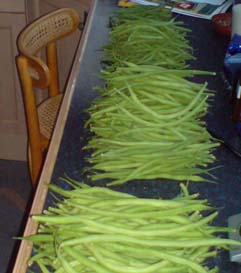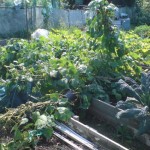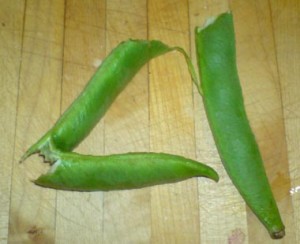Beans – Runner, Dwarf & French Climbing
Today I picked 3.5lb (1.5Kg) runner beans, 2.5lb (1.25Kg) of dwarf French beans and 1.5lb (0.7Kg) of climbing French beans. Last week we picked about 10lb (4.5Kg) of beans of various descriptions, mostly dwarf French. The week before it was about 6lb (2.5Kg). I think that we have about the same amount still to come as well!
Updates:
- 23/8/2010: Disaster, the wind blows over some of the climbing French beans! They may continue to grow as trailing beans?
- 27/8/2010: Runners 2.75 lb, dwarf 2lb and climbing French 8oz
- 30/8/2010: Runners 2.25lb, dwarf 1lb 6oz and climbing French 1lb 4oz – yes they are still producing but only just!
- 2/9/2010: Runners 1.5lb, dwarf 1.5lb and climbing French 1lb – lack of water affecting yield?
- We picked the last of the beans yesterday, 16th October 2010, about 600g. We stopped weighing the crop some time ago.
The varieties that we grow are:
- Runner Bean; Enorma, a traditional English variety, good to eat and freezes well
- Dwarf Bean; Aguillon (a french variety bought in France), very tender and slow to go stringy
- Climbing French Bean; Blue Lake, not a very large variety but gives lots of tender pods.
We try to make sure that we have a continuous supply from about mid/late-July when the dwarf beans start, through August when we pick mainly runner beans with the climbing French type coming to a peak late August and continuing into September.
We do not grow a vast quantity of any type, a 20′ (6m) double row row of runner beans, about the same of dwarf beans and about a 10′ (3m). the runner beans are sown as two lots with a 3 week interval so as to stagger the supply, the dwarf French as 5 lots at 2 week intervals and the climbing French as 2 lots with 3 weeks between.
We harvest runner beans when they are slightly under developed, this helps avoid some of the “stringiness” when cooked. Dwarf and climbing french beans are harvested at various stages of development, this allows us to optimise both yield and quality. Both of these types have the best flavour and quality when the are harvested young and immature but this does dramatically reduce the yield and the younger crop does not freeze well. As they mature they go through a phase where they have reached full length and are just beginning to swell. At this point you get the best compromise between quality, flavour and yield. Allow them to swell a little and the flavour begins to reduce but the yield rises, at this point on they are suitable for freezing. Finally when they are fully developed, although the yield is high and the crop will freeze well, the beans tend to be stringy and take much more preparation.
The best test as to the state of the crop is to take one or two and break them in half. If they are getting fat and break cleanly with no string then they are probably ready. If they break like the picture, then they are past their best and either eaten straight away after removing the string or thrown away in extreme cases.
Update 18th October 2010: we pulled up all the bean plants yesterday as the first frost had really damaged them and we would get no more beans. All the plants, including the roots, went on the compost heap. Traditional methods said to leave the roots together with the nitrogenous nodules in the ground. Modern theory is that most of the nitrogen has gone by this time of year.
Given the quantity that we harvest, we obviously cannot eat them all at once so we freeze as many as possible.
Freezing is easy provided that you have everything organised. First of all, sort the beans into heaps with beans of similar size. Then divide the heaps into easily manageable lots, around 0.5lb (250g) is good for us. Dice runner beans as you prefer, cut longer climbing and dwarf beans into easily manageable lengths, about 5 to 7cm (2 to 3″). Heat about 2 – 3 litres of water to boiling in a large pan, don’t be tempted to use too little water as you want the beans to blanche quickly, if there is too little water they will start to cook while heating. Prepare a large bowl with about 4 litres of cold water.
When the water is at a rolling boil, put in the beans and bring back to the boil quickly, leave boiling for 1 minute and then remove the beans quickly to the cold bowl. Leave them to cool for about 2 minutes, drain carefully and put into labelled freezer bags. Allow to cool completely and then put into the quick freeze compartment of the freezer.
We have successfully kept beans like this for over a year but 1 year should be your guide limit.
What ever you do, do not re-freeze defrosted beans or any other blanched produce once it has thawed.
Here is a recipe to help you appreciate the beans that you have grown, good as a side dish with curries and chinese meals:
Spiced Green Beans with Cashew Nuts


